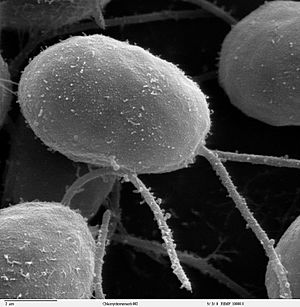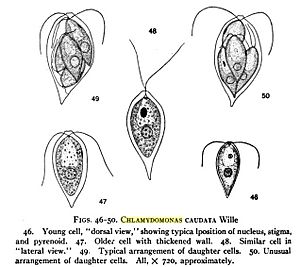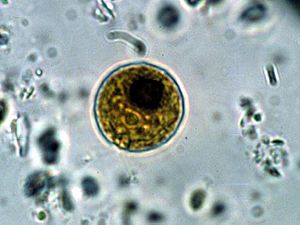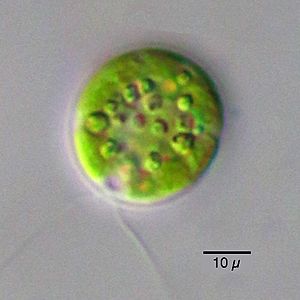Chlamydomonas facts for kids
Quick facts for kids Chlamydomonas |
|
|---|---|
 |
|
| SEM image of flagellated Chlamydomonas (10000×) | |
| Scientific classification |
|
| Phylum: | Chlorophyta |
| Class: | Chlorophyceae |
| Order: | Chlamydomonadales |
| Family: | Chlamydomonadaceae |
| Genus: | Chlamydomonas Ehrenb. |
| Species | |
|
See text |
|
Chlamydomonas is a genus of green algae consisting of about 325 species all unicellular flagellates, found in stagnant water and on damp soil, in freshwater, seawater, and even in snow as "snow algae". Chlamydomonas is used as a model organism for molecular biology, especially studies of flagellar motility and chloroplast dynamics, biogenesis, and genetics. One of the many striking features of Chlamydomonas is that it contains ion channels (channelrhodopsins) that are directly activated by light. Some regulatory systems of Chlamydomonas are more complex than their homologs in Gymnosperms, with evolutionarily related regulatory proteins being larger and containing additional domains.
Molecular phylogeny studies indicated that the traditional genus Chlamydomonas defined using morphological data was polyphyletic within Volvocales, and many species were reclassified (e.g., in Oogamochlamys, Lobochlamys), and many other "Chlamydomonas" lineages are to be reclassificated.
Contents
Description
Unicellular cells, spherical or slightly cylindrical, a papilla may be present or absent. Chloroplasts green and usually cup-shaped. A key feature of the genus is its two anterior flagella, each as long as the other.
Species
- Chlamydomonas acidophila
- Chlamydomonas caudata Wille
- Chlamydomonas ehrenbergii Gorozhankin
- Chlamydomonas elegans G.S.West 1915
- Chlamydomonas moewusii
- Chlamydomonas nivalis
- Chlamydomonas ovoidae
- Chlamydomonas reinhardtii
Ecology
Chlamydomonas is widely distributed in freshwater or damp soil. It is generally found in a habitat rich in ammonium salt. It possesses red eye spots for photosensitivity and reproduces both asexually and sexually.
Chlamydomonas's asexual reproduction occurs by zoospores, aplanospores, hypnospores, or a palmella stage, while its sexual reproduction is through isogamy, anisogamy or oogamy.
Nutrition
Most species are obligate phototrophs but C. reinhardtii and C. dysostosis are facultative heterotrophs that can grow in the dark in the presence of acetate as a carbon source.
Morphology
- Motile unicellular algae.
- Generally oval.
- Cell wall is made up of a glycoprotein and non-cellulosic polysaccharides instead of cellulose.
- Two anteriorly inserted whiplash flagella. Each flagellum originates from a basal granule in the anterior papillate or non-papillate region of the cytoplasm. Each flagellum shows a typical 9+2 arrangement of the component fibrils.
- Contractile vacuoles are near the bases of flagella.
- Prominent cup or bowl-shaped chloroplast is present. The chloroplast contains bands composed of a variable number of the photosynthetic thylakoids which are not organised into grana-like structures.
- The nucleus is enclosed in a cup-shaped chloroplast, which has a single large pyrenoid where starch is formed from photosynthetic products. Pyrenoid with starch sheath is present in the posterior end of the chloroplast.
- Eye spot present in the anterior portion of the chloroplast. It consists of two or three, more or less parallel rows of linearly arranged fat droplets.
See also
 In Spanish: Chlamydomonas para niños
In Spanish: Chlamydomonas para niños





